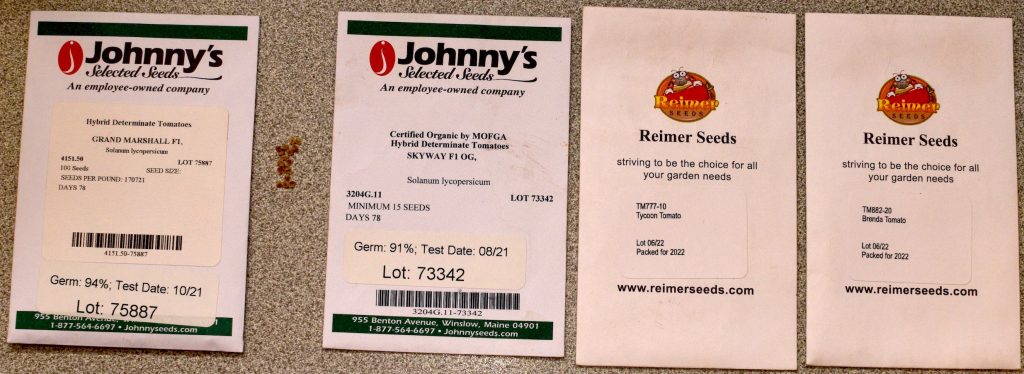I have planted my 2023 spring tomatoes over the past two weeks. Standard gardening advice is to plant tomato seeds 6–8 weeks before you anticipate putting the transplants in your garden. The best time for transplants is when all danger of frost has passed and overnight lows are 50 °F (10 °C) or above. For me, it’s now 8 weeks until that time. As such, I planted my tomatoes 1 or 2 weeks earlier than recommended. This is not a big deal. Last year, an early heat wave stopped my plants from setting fruit at what should have been the peak of their productivity. So I wanted to be sure to avoid that this year.

Tomato seed packets and some tomato seeds. All these varieties are TYLCV-resistant cultivars given disease pressures in my area.
The tomato (Solanum lycopersicum) is a member of the nightshade family (Solanaceae), along with potatoes, peppers, tobacco, petunias, and others. This group also includes the poisonous plants Datura spp. (jimsonweed) and Atropa belladonna (deadly nightshade) — both of which of which I grow in my garden.
Planting Tomato Seeds
Planting tomatoes is very straightforward. To do so, fill your flats with potting mix and shake them to settle the soil. Take your finger and press lightly in the middle of each well of the flat, making a depression roughly 1/8” (0.3 cm) deep. Place one seed in each depression and sprinkle potting mix over each seed until it is covered. Getting the exact depth is not important. If you plant the seeds way too deep, over 1/2” (1.3 cm), the seedling will not reach the surface. Too shallow, and the seedling may fall over. However, anywhere in the ballpark of 1/8” (0.3 cm) will work fine. Another rule of thumb is that each tomato seed should be covered to a depth of roughly 3 seed widths.

Some newly sprouted tomatoes (left) and some slightly older tomatoes (right). When first sprouted, the plants unfurl their two cotyledons (seed leaves); next their first true leaves emerge from the stem, at right angles to the cotyledons.
Tending to Planted Seeds and Seedlings
While the seeds are sprouting, you will need to keep the potting mix damp. Tomatoes will do best when sprouted at 65–85 °F (18–30 °C). This is a wide range and standard room temperature falls within it. A seedling heating mat will bring seeds to the upper end of this range. I used a heating mat and my seeds started germinating on day 5. Of course, warm and damp is an invitation for mold or other fungi to start growing. However, tomatoes sprout more quickly than any fungus can get going, so it’s not a problem.

Tomato seedlings in flats (left) and in 6″ planters (right). The true leaves have extended to become branches, from which multiple, multi-lobed leaves grow.
I keep the seedlings indoors overnight, where the temperature is 68–70 °F (20–21 °C), but set them out in the sunshine when the temperature outside is above 50 °F (10 °C). On days when they can’t get any outside sun, they sit by a window and I turn on my grow light. During the seedling stage is when fungi can become a problem. To deter the growth of fungi, remove the flats from the heating mat and allow the top of the potting mix to dry out, or nearly so, between waterings.

In a couple months the plants will produce small, yellow flowers and set fruit. These are tomatoes from last year (2022).
I’m in USDA Plant Hardiness Zone 8B, so my gardening season is going to start a bit before most gardeners in the US. Keep watching this website for more vegetable gardening information.


Recent Comments